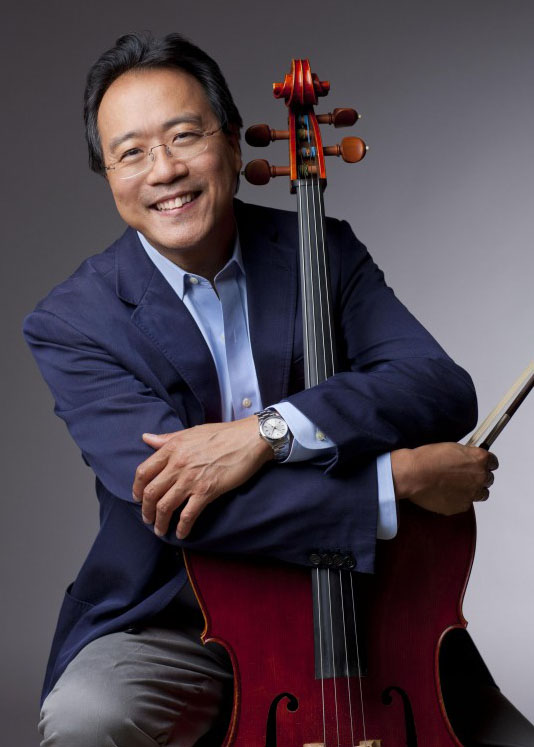Some of the ideas for my Cello Concerto can be traced back by at least three decades, but the actual material for the piece was mostly developed in the summer of 2015 when I decided to spend a few months researching for new kinds of textures without a concrete plan how to use them. I decided to use some phrases from my 2010 solo cello work …knock, breathe, shine… in the second and third movements as I always felt that the music of the solo piece was almost orchestral in its scope and character, and would function well within an orchestral environment.
I have never — not even during the quite dogmatic and rigid modernist days of my youth — felt that the very idea of writing a solo concerto would in itself be burdened with some kind of dusty bourgeois tradition. A concerto is simply an orchestral work where one or several instruments have a more prominent role than the others. A concerto does not suggest a formal design the same way a symphony does.

Yo-Yo Ma
I also happen to like the concept of a virtuoso operating at the very limits of what is physically (and sometimes mentally) possible. In Nietzsche’s words: “You have made danger your vocation; there is nothing contemptible in that.” (No program note feels complete without a quotation from Thus Spoke Zarathustra.) I have learned, however, that virtuosity doesn’t limit itself to the mechanics of playing an instrument. A true virtuoso can also capture the beauty and expression in the quietest moments, to fill near-stasis with life through a musician’s imagination and ability to communicate. In my other life as a performer, I witness that almost every day: how musicians can create meaning from a single note. The composer-me is humbled by it, but also deeply grateful. After all, all those symbols on paper mean nothing until somebody gives them life.
It has been a very great pleasure and honor to write a concerto for one of the most unique life-givers and communicators of our time, Yo-Yo Ma. It has been inspiring to know that his technique knows no limits. Perhaps more importantly: nor does his imagination.
The first movement opens with what in my sketchbook had the title “Chaos to line.” Chaos here must be understood metaphorically, as a stylized version of the idea. I like the concept of a simple thought emerging out of a complex landscape. Almost like consciousness developing from clouds of dust.
This leads to the second semi-cosmological metaphor: a comet. I imagined the solo cello line as a trajectory of a moving object in space being followed and emulated by other lines/instruments/moving objects. A bit like a comet’s tail. In musical terms, it could be described as a canon but not quite as the imitation is not always literal or precise. The gestus remains however almost identical every time.
Sometimes the imitating cloud flies above the cello, sometimes in the very same register. It thins out to two lines and finally to one.
There are faster, more playful episodes alternating with the cloud, and finally the movement gains enough speed for the balance to tilt toward fast music. At the end, a variation of the cloud returns.
The second movement is very simple in form, more complex in texture. It starts with a wedge-formed cloud [>] and ends with another [<], if one can imagine such a thing. The slow cello arches are looped to create harmony from single lines. Sometimes the loops are dispersed in space. The middle section is a playful duet between the solo cello and the alto flute.
The third movement starts with a slow, brooding cello solo under the residue of the second wedge-cloud. The expression quickly becomes more extroverted through a series of accelerandi. A rhythmic mantra starts to develop in the congas and bongos. It will appear often later in the course of the movement, mostly in the timpani. This music is often dance-like; sometimes gesticulating wildly, perhaps from the sheer joy of no longer having nothing to do with clouds and processes.
An acrobatic solo episode leads to a fast tutti section where I imagined the orchestra as some kind of gigantic lung, expanding and contracting first slowly, but accelerating to a point of mild hyperventilation, which leads back to the dance-like material. Quixotic solo cello episodes lead to a joyful coda based on the “lung” music, but now with a solo cello line. Finally the kinetic energy burns itself out gently, the rapid movement slows down, and the cello line climbs slowly up to a stratospherically high B-flat, two centimeters to the left from the highest note of the piano.
TOP: Esa-Pekka Salonen, whose Cello Concerto will receive its world-premiere performances March 9-11 with the CSO. | Photo: Benjamin Suomela